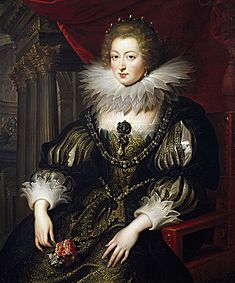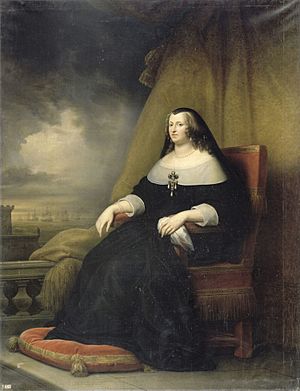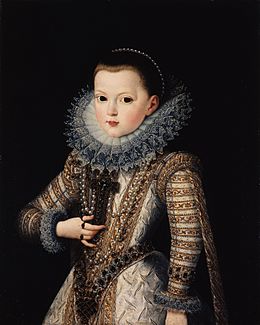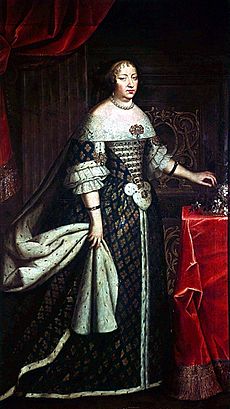Anne of Austria facts for kids
Quick facts for kids Anne of Austria |
|||||
|---|---|---|---|---|---|

Portrait after Peter Paul Rubens, c. 1620s
|
|||||
| Queen consort of France | |||||
| Tenure | 24 November 1615 – 14 May 1643 | ||||
| Queen consort of Navarre | |||||
| Tenure | 24 November 1615 – 20 October 1620 | ||||
| Queen regent of France | |||||
| Regency | 14 May 1643 – 7 September 1651 | ||||
| Monarch | Louis XIV | ||||
| Born | 22 September 1601 Benavente Palace, Valladolid, Spain |
||||
| Died | 20 January 1666 (aged 64) Paris, France |
||||
| Burial | Basilica of St Denis, Paris, France | ||||
| Spouse | |||||
| Issue | |||||
|
|||||
| House | Habsburg | ||||
| Father | Philip III of Spain | ||||
| Mother | Margaret of Austria | ||||
| Religion | Roman Catholicism | ||||
| Signature |  |
||||
Anne of Austria (French: Anne d'Autriche, Spanish: Ana María Mauricia; born September 22, 1601 – died January 20, 1666) was a Spanish princess. She became the Queen of France when she married King Louis XIII in 1615. She was also Queen of Navarre until 1620.
After her husband died in 1643, Anne became the Queen Regent for her young son, Louis XIV. She ruled France until 1651. During her time as regent, Cardinal Mazarin was France's most important minister. People at the French court often talked about her difficult marriage and her close bond with her son.
Contents
Early Life of Anne of Austria
Anne was born in Valladolid, Spain, on September 22, 1601. Her full name was Ana María Mauricia. She was the oldest daughter of King Philip III of Spain and his wife, Margaret of Austria.
She was known as an Infanta of Spain and Portugal. She was also an Archduchess of Austria. Even though she was born in Spain, she was called Anne of Austria. This was because her family, the rulers of Spain, belonged to the House of Austria.
Anne grew up mostly in the Royal Alcazar of Madrid. She was very close to her parents, who were quite religious. Anne was also raised to be religious. She often visited monasteries when she was a child. In 1611, her mother passed away during childbirth. Anne was sad, but she worked hard to care for her younger brothers and sisters. They lovingly called her their mother.
Queen of France
When Anne was eleven, she was promised in marriage to King Louis XIII of France. Her father gave her a large dowry of 500,000 crowns and many beautiful jewels. If Louis XIII died early, she was supposed to return to Spain with her dowry and jewels.
Before the wedding, Anne gave up her right to the Spanish throne. This meant she and her children with Louis could not become rulers of Spain. On October 18, 1615, Anne and Louis were married by proxy (someone stood in for them) in different cities. These marriages helped strengthen the friendship between France and Spain.
Anne was lively and pretty when she was young. She was also a skilled horse rider, a hobby her son Louis would also enjoy. Many people admired Anne.

Anne and Louis were both fourteen years old. They were encouraged to start their marriage properly. However, Louis often ignored his new wife. Louis's mother, Marie de' Medici, continued to act as the main queen. She did not show much respect to Anne. Anne was surrounded by her Spanish ladies-in-waiting. She continued to follow Spanish customs and did not learn French well.
In 1617, Louis worked with his friend Charles d'Albert de Luynes to remove his mother's influence. Louis's mother's favorite, Concino Concini, was killed. Luynes then tried to bring Louis and Anne closer. He sent away Anne's Spanish ladies and replaced them with French ones. Anne started to dress in the French style. Over time, they grew to care for each other. Louis even seemed worried when Anne was very sick.
The king was focused on his war against the Protestants. Meanwhile, the queen supported her close friend Marie de Rohan. Marie was often involved in court secrets.
Louis then chose Cardinal Richelieu as his main advisor in 1624. Richelieu's goal was to fight against the Habsburg family, who ruled Spain and Austria. This caused problems between Louis and Anne, as Anne was from the Habsburg family. Anne and Louis did not have children for sixteen years.
Anne was influenced by Marie de Rohan. She became involved in plots against Cardinal Richelieu's plans. There were rumors that she was involved in secret plans against the king's government.
In 1626, Cardinal Richelieu placed a spy, Madeleine du Fargis, in Anne's household. But Madeleine became a trusted friend of the queen instead. In 1630, Louis XIII reduced Anne's court. He removed many of her friends as punishment. This was because Anne had worked with the queen mother, Marie de' Medici, to try and remove Cardinal Richelieu from power. Anne asked Richelieu to let her keep du Fargis, but he refused. Anne swore she would never forgive him.
In 1635, France declared war on Spain. This put Queen Anne in a difficult situation. She had secret letters with her brother, Philip IV of Spain. She also wrote to the Spanish ambassador and the governor of the Spanish Netherlands. Her servant, La Porte, helped deliver these secret messages.
By August 1637, Anne was highly suspected. Richelieu started an investigation. Her courier La Porte and the head of Anne's favorite convent, Val-de-Grâce, were questioned. They admitted to helping Anne with her secret letters. Anne first swore she had done nothing wrong. But on August 15, she admitted her guilt. On August 17, Queen Anne had to sign an agreement. Her letters would now be checked. She was also not allowed to visit convents without permission. She always had to be with one of her ladies-in-waiting.
Conventual Patronage and the Val-de-Grâce
As a queen, Anne visited churches and convents. She met Marguerite de Veny d'Arbouze at a convent. In 1618, Anne helped Marguerite become the Abbess (head nun) at the Benedictine Val-de-Grâce convent. Anne also bought land and moved the convent to Paris in 1621. She was named the new founder of the convent that same year.
Anne paid for a small church and an apartment for herself at the convent between 1620 and 1625. She did this even though Louis and Cardinal Richelieu did not want her to.
Anne ordered the building of the Val-de-Grâce church in 1645. It became Anne's main place of worship. It also became important during a rebellion called the Fronde, when Anne was Queen Regent. In 1662, Anne placed the heart of her ancestor, Anne Elizabeth of France, in the Chapel of Saint Anne. Anne herself was buried there in 1666.
Birth of an Heir
Louis XIV was born on September 5, 1638. This was a very important event because it secured the royal family's future. Anne was 37 years old at the time. The official newspaper called the birth "a marvel when it was least expected."
Even with a son, the king and queen did not become closer. However, Anne became pregnant again fifteen months later. On September 21, 1640, Anne gave birth to her second son, Philippe I, Duke of Orléans. He later started the modern House of Orléans family line. Both of her children were cared for by the royal governess Françoise de Lansac. Anne did not like her, but she was loyal to the king and the cardinal.
Cardinal Richelieu gave his large home, the Palais Cardinal, to Louis XIII in 1636. But the king never lived there. Anne left the Louvre Palace to live there with her two young sons. She stayed there as regent, which is why it is still called the Palais-Royal today.
Regent of France

When Louis XIII died in 1643, Anne was named regent. This meant she would rule until her son, Louis XIV, was old enough. Louis XIII had tried to limit her power, but Anne used the Parlement de Paris to change his will. This gave her full power. Her four-year-old son was crowned King Louis XIV of France.
Anne became regent, and to everyone's surprise, she gave the government to Cardinal Mazarin. He had been a student of Cardinal Richelieu. Mazarin moved into the Palais Royal, close to Queen Anne. They became very close.
With Mazarin's help, Anne stopped a rebellion by nobles. This rebellion was led by Louis II de Bourbon, Prince de Condé. It was known as the Fronde. In 1651, her son Louis XIV officially became old enough to rule. This meant her regency legally ended. However, she still had a lot of power and influence over her son until Mazarin died.
In January 1648, Anne received a request from artists. These artists wanted to be independent from the old art guilds. The guilds would fine artists or take their work. The painters and sculptors asked Louis XIV and Queen Anne to form a new group. They wanted to create an academy for visual arts, like the Académie Française for French literature. This became the Académie Royale.
Later Life
Anne's time as regent officially ended in 1651. Her son, Louis XIV, was declared old enough to rule at age thirteen.
In 1659, the war with Spain ended with the Treaty of the Pyrenees. The next year, peace was made stronger by the marriage of the young King Louis XIV to Anne's niece, Maria Theresa of Spain.
In 1661, the same year Mazarin died, Anne's first grandchild, Louis, was born. Many other children would follow, but only Louis would live to adulthood. Sometime after, Anne retired to the convent of Val-de-Grâce. She died there five years later from breast cancer.
Issue
Anne and Louis XIII had the following children:
| Name | Lifespan | Notes | |
|---|---|---|---|
| stillborn child | Dec 1619 | ||
| stillborn child | 14 Mar 1622 | ||
| stillborn child | 1626 | ||
| stillborn child | Apr 1631 | ||
| Louis XIV of France | 5 Sep 1638 – 1 Sep 1715 | Married Maria Theresa of Austria (1638–83) in 1660. Had children. | |
| Philippe of France, Duke of Orléans | 21 Sep 1640 – 8 Jun 1701 | Married (1) Princess Henrietta of England (1644–70) in 1661. Had children. Married (2) Elisabeth Charlotte of the Palatinate (1652–1722) in 1671. Had children. |
In Fiction
Anne of Austria is a main character in Alexandre Dumas's 1844 novel The Three Musketeers. She also appears in its follow-up books, Twenty Years After (1845) and The Vicomte de Bragelonne (1847-1850). Because of this, she has been played by many actresses in film versions.
Her lady-in-waiting, Madame de Motteville, wrote about the queen's life in her book Mémoires d'Anne d'Autriche.
She was played by Alexandra Dowling in the BBC series The Musketeers (2014–2016).
She appears as a young teen in the Dinosaur King season two episode "The French Conniption."
She appeared in the Legends of Tomorrow season two premiere episode "Out of Time," played by Rebecca Roberts.
She appeared in the final episode of the third season of the series As If, played by Yeşim Ceylan.
Gallery
-
Anne of Austria, 1622, by Peter Paul Rubens (Prado)
-
Equestrian portrait of Anne (Versailles)
See also
 In Spanish: Ana de Austria (reina de Francia) para niños
In Spanish: Ana de Austria (reina de Francia) para niños









